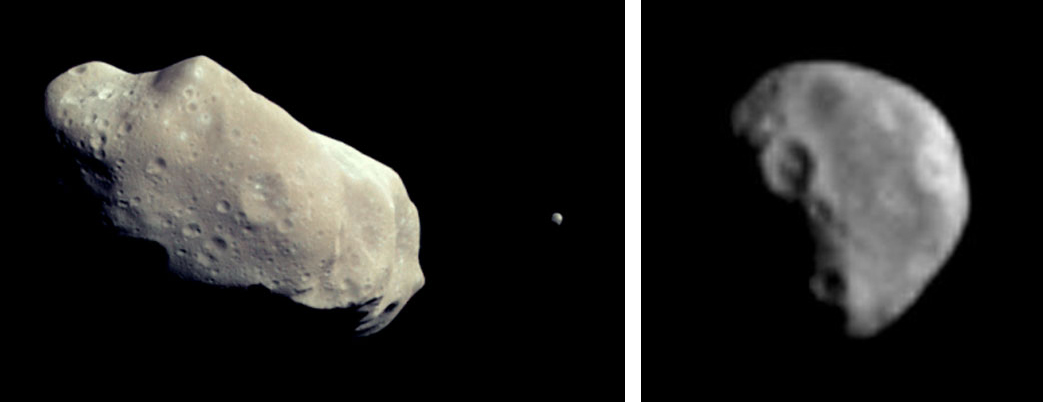
The “Special Topics” presentation four weeks ago was on the subject of the small moons of the various planets in the solar system. It would seem reasonable to think that the bodies that possess moons don’t stop with the major planets, but that many of the “small bodies” that are the focus of “Ice and Stone 2020” also possess moons. Indeed, this has been found to be true.
What could perhaps be considered as the first confirmed moon of a “small body” is Pluto’s large moon Charon, which was discovered in 1978 (and which is discussed as part of the overall “Special Topics” presentation on Pluto several weeks ago). However, since Pluto somewhat straddles the (arbitrary) line between what is and what is not a “planet” – being a member of the recently-created category of “dwarf planets” – and since Charon is a unique world in its own right that is 1.3 times the diameter of (1) Ceres and thus would be a “dwarf planet” were it not part of the Pluto system, it would seem to be stretching things a bit to refer to it as a “small body” moon. At around the same time as Charon’s discovery, a couple of moons around main-belt asteroids were suspected as a result of one-time occultation events, however neither of these reported objects has been confirmed. The first confirmed example of a moon accompanying an asteroid finally came on August 28, 1993, when NASA’s Galileo spacecraft flew by the main-belt asteroid (243) Ida – which is 60 km by 19 km in size in its longest and shortest dimensions – and images taken during the flyby revealed a 1.5-km somewhat spherical moon that has since been named Dactyl.
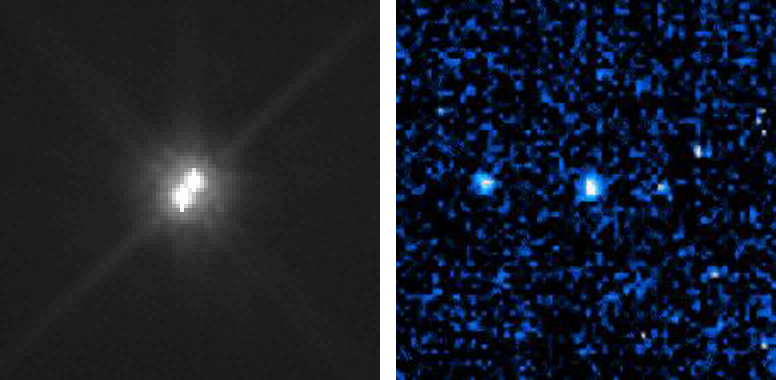
Since that time over 400 moons orbiting around “small bodies” in the solar system have been detected, although, curiously, besides Dactyl and one short-lived exception none of these have been found by visiting spacecraft despite all the various objects that have been visited. They have been discovered via a variety of techniques and around bodies all over the solar system, from near-Earth asteroids, to the main asteroid belt, to “Jupiter Trojan” asteroids – discussed in a future “Special Topics” presentation – and the Kuiper Belt (discussed in last week’s “Special Topics” presentation). Some of the moons are tiny objects relative to their primary body, like Dactyl, while others are large enough such that the objects in question can almost be considered as “binary” systems, in a manner that the Pluto/Charon system can perhaps be so considered. Overall, the consensus among astronomers is that roughly 2% of asteroids in the main belt and in the near-Earth population contain moons, although based upon what has been detected thus far that percentage goes up to about 11% for objects within or beyond the Kuiper Belt.
Many of the asteroid moons have been discovered via direct detection, either with the Hubble Space Telescope or with large ground-based telescopes, often equipped with “adaptive optics” systems (that compensate for atmospheric turbulence). The first-discovered asteroid from the ground, which was also the first confirmed asteroidal moon after Dactyl, was detected around the large main-belt asteroid (45) Eugenia on November 1, 1998, by a team led by William Merline using the 3.6-meter Canada-France-Hawaii Telescope (CFHT) at Mauna Kea Observatory in Hawaii. This moon originally designated S/1998 (45) 1 and now formally named Petit-Prince, is roughly 13 km in diameter (as compared to 214 km for Eugenia itself) and orbits around Eugenia every 4.8 days.
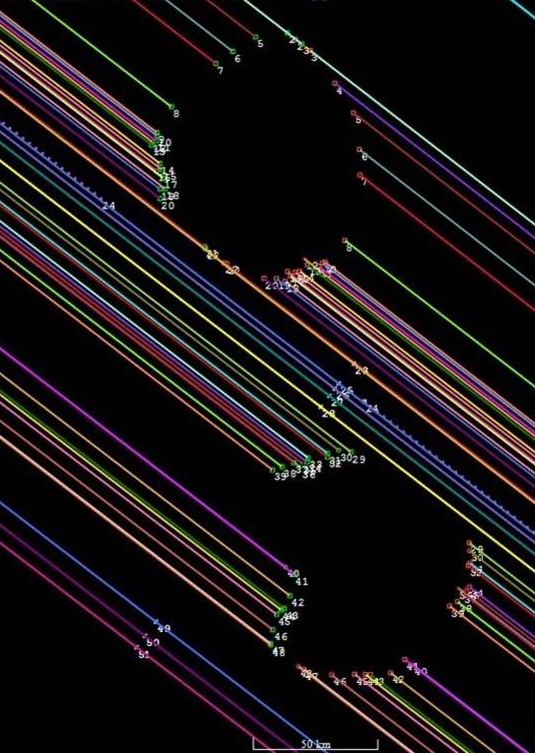
Direct imaging is, in large part, the only feasible method of detecting moons around more distant asteroids. The first moon around a “Jupiter Trojan” asteroid was discovered on September 22, 2001 – again by Merline’s team, this time using the 8.1-meter Gemini North Telescope on Mauna Kea – around (617) Patroclus (which is a destination for NASA’s upcoming Lucy mission, discussed in a previous “Special Topics” presentation). The first Kuiper Belt object (other than Pluto) found to have an accompanying moon is 1998 WW31; the moon was discovered on December 22, 2000, by a team led by Christian Veillet utilizing the CFHT.
Some asteroid moons have been detected during occultation events – a subject covered in a previous “Special Topics” presentation. Even for moons discovered via other methods, occultations – especially those observed by a large number of observers aligned across the event’s path – can provide detailed information about a moon’s – and parent body’s – size and shape.
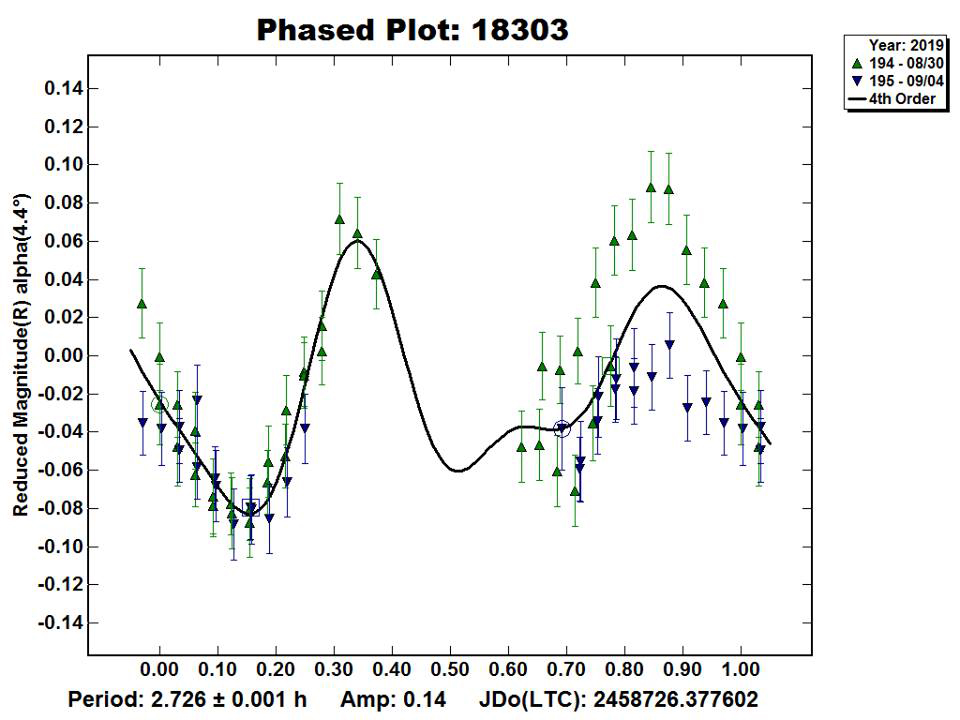
Additional moons have been discovered by means of time-resolution photometry – usually by teams of observers located at different sites around the world. Almost all asteroids exhibit regular and periodic changes in their brightness as a result of rotation, but the presence of a moon can introduce additional changes in brightness as a result of passing in front of and behind its parent object (as well as its own rotation). The “light curve” of such a system can be complex and can require a detailed mathematical analysis to untangle, but the end result can reveal physical information about both objects as well as parameters of the moon’s orbit around its parent body.
Especially for asteroids that pass near Earth, another method of detecting accompanying moons is via radar bounce experiments. Both the large 300-meter Arecibo radio telescope in Puerto Rico (which recently suffered a significant structural accident) and the 70-meter Deep Space Network tracking antenna in Goldstone, California have been used extensively in bouncing radar signals of Earth-approaching asteroids (and comets as well), and in addition to providing information about an object’s surface topography these experiments have also found several of these objects to be accompanied by moons. The moon of the Amor-type asteroid (65803) Didymos – recently given the name Dimorphos, and the destination of NASA’s planned Double Asteroid Redirection Test (DART) mission, discussed in a previous “Special Topics” presentation – was discovered by photometry during an approach to Earth in 2003 but was also confirmed around that same time by radar bounce experiments conducted at Arecibo.
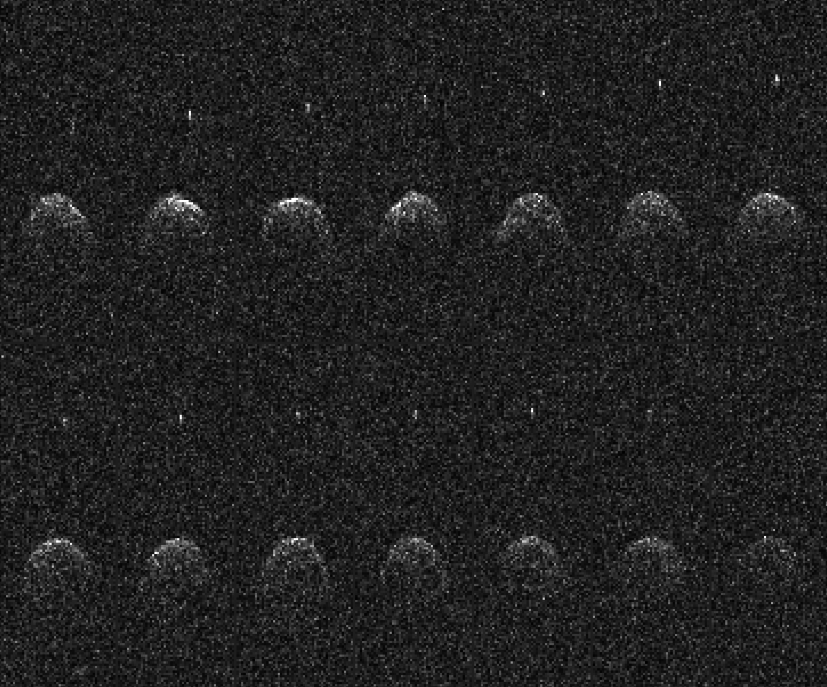
Those asteroids that have moons are not necessarily restricted to having just one moon; at this writing, at least 15 are known to have two or more moons. Pluto, as was discussed in its “Special Topics” presentation, has five known moons, and the “dwarf planet” (136108) Haumea has two moons, as does at least one other known Kuiper Belt object, (47171) Lempo. The first main-belt asteroid known to have two moons is (87) Sylvia, the first of these being discovered in 2001 via the Keck II 10-meter telescope at Mauna Kea, the second one being discovered in 2004 from the European Southern Observatory in Chile; these two objects have been named Romulus and Remus, after the mythical founders of Rome. (45) Eugenia, as it turns out, also has a second moon, this one being discovered in 2004 and being about half the size of Petit-Prince; it is not been formally named as this time but is designated as S/2004 (45) 1. At least three near-Earth asteroids are now known to have two moons: the Amor-type asteroids (3122) Florence – one of the largest near-Earth asteroids – and (153591) 2001 SN263, and the Apollo-type asteroid (136617) 1994 CC. (153591) 2001 SN263 is the scheduled destination of the planned Brazilian ASTER mission (discussed in a previous “Special Topics” presentation).
The origins of these asteroidal moons are not known with any real certainty, and in fact, the origins may vary in specific cases. Especially in those cases where a large disparity in size exists, it would seem likely that the moons are debris knocked off the parent body via an impact at some point in the past. In other cases, especially the “binary” asteroids where the moons are of similar size compared to their parent body, some type of “capture” scenario may be involved. This may also be true in those cases where the orbital separation is quite large; for example, the moon (roughly seven km across) of the large main-belt asteroid (379) Huenna (about 90 km in diameter) orbits at a distance of 3400 km.
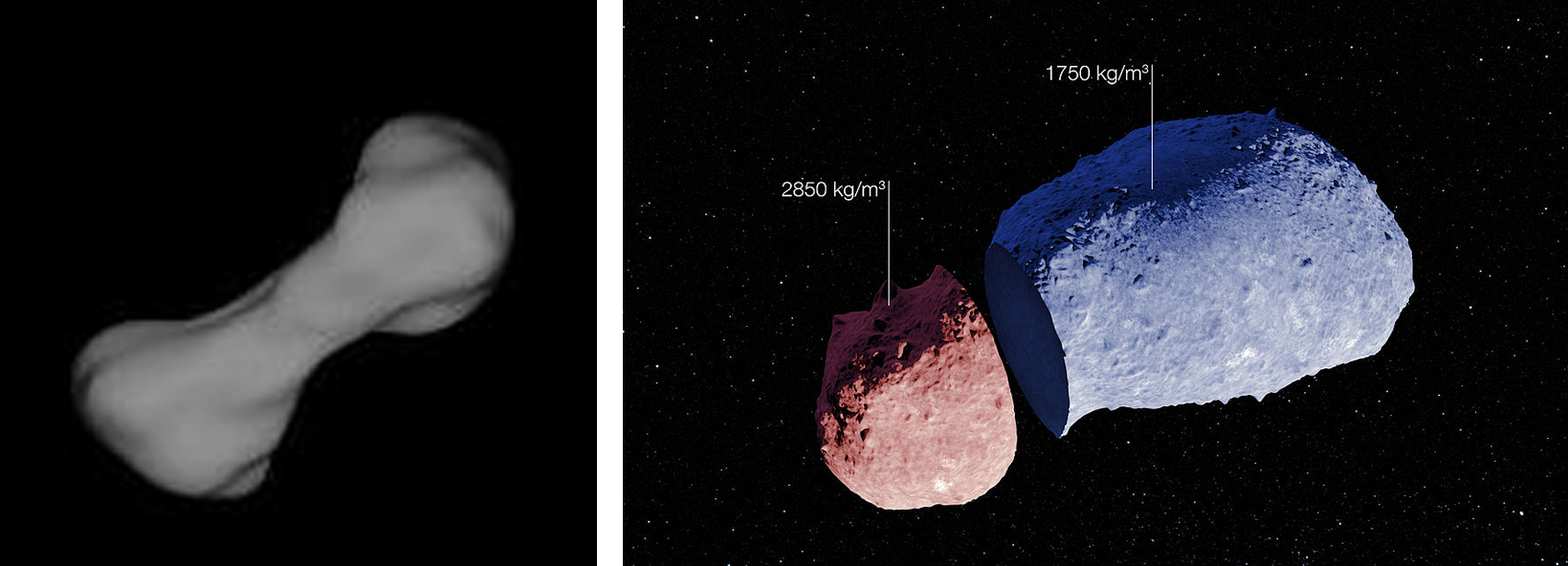
All of the above parent bodies of “small bodies” moons are asteroids; as of now, there are no confirmed cases of moons around comets, although this may well be due to the clouds of obscuring material that prevents close examination of cometary nuclei. In October 2015 images taken of the nucleus of Comet 67P/Churyumov-Gerasimenko – a previous “Comet of the Week” – by ESA’s Rosetta mission revealed the presence of a small four-meter-wide object, informally dubbed “Churyumoon,” orbiting the nucleus at a distance of 2 to 3 km, however, this object only survived two days before disappearing (and apparently dissipating).
Although these are not parent body/moon systems per se, what appears to be a non-trivial fraction of the solar system’s “small bodies” are what are called “contact binaries,” i.e., two objects seemingly stuck together. The best-known examples are Comet 67P/Churyumov-Gerasimenko which was visited by ESA’s Rosetta mission and the Kuiper Belt object (486958) Arrokoth which was visited by NASA’s New Horizons mission in early 2019, however several of the objects that have been radar-imaged as well as a few others that have been visited by spacecraft exhibit this same basic structure. It is rather likely that most, if not almost all, of these “contact binaries” started out as two separate objects that collided – presumably with a low relative velocity – and stuck together via mutual self-gravity. Such an interpretation seems especially likely in the case of the Apollo-type asteroid (25143) Itokawa, which was visited and orbited by JAXA’s Hayabusa mission in 2005; based upon detailed studies conducted with the New Technology Telescope at the European Southern Observatory in Chile, the two lobes exhibit dramatically different overall densities and thus clearly must represent two different objects that collided and became one.
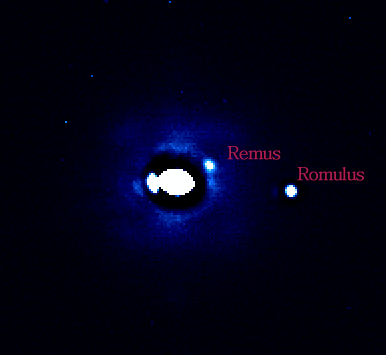
The presence of these “contact binaries” in the solar system today helps reinforce our models of how the planets in our solar system originally formed. According to these models, in the early days of the solar system when the population of “small bodies” was much larger and more crowded than it is today, they collided and stuck together, growing larger and gravitationally attracting additional objects. Eventually, these accumulating “planetesimals” grew large enough to become “protoplanets” – objects the size of (1) Ceres and (4) Vesta, which are likely surviving objects of this type – with these then becoming the seed material of the planets that exist today. The comets and asteroids that we see now are the “leftovers” of this long-ago process and can accordingly provide valuable clues as to the conditions that existed at that time. This is a significant part of the reason why astronomers are so interested in these objects in the first place, for they can tell us a lot about our own origins.
More from Week 37:
This Week in History Comet of the Week Free PDF Download Glossary
Ice and Stone 2020 Home Page


